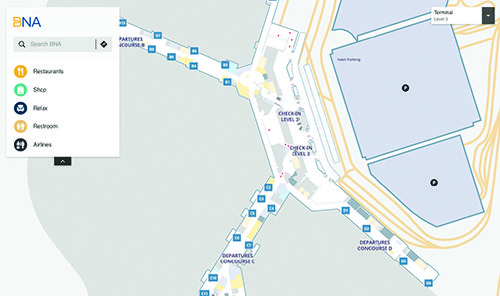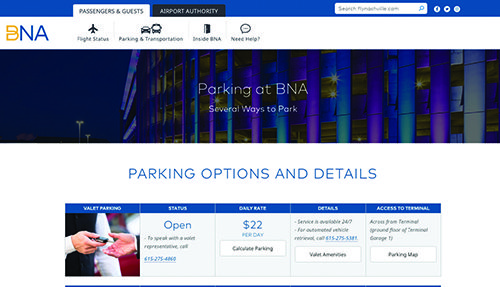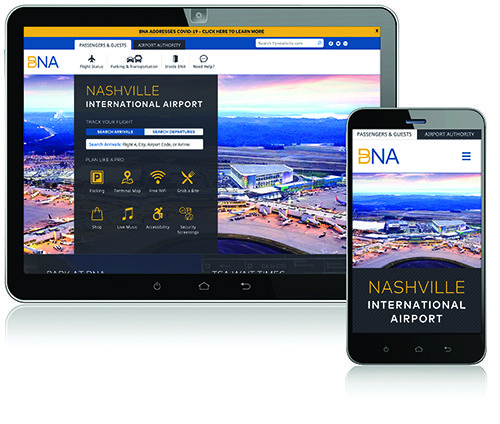Nashville International Airport (BNA) has completed numerous brick-and-mortar improvements in recent years to keep pace with the region’s booming economy and population growth. And now, BNA has an improved online presence as well.
Nashville International Airport (BNA) has completed numerous brick-and-mortar improvements in recent years to keep pace with the region’s booming economy and population growth. And now, BNA has an improved online presence as well.
 A new website, launched in April, provides detailed information for travelers and those looking to understand the business side of the airport. One of the site’s key features is an interactive map of the terminal that provides guests with updated information about key features such as airline counters, concessions and services. The new interactive map is a marked upgrade from the static PDF image the airport used to provide. Now users can simply click on images or words for more information and greater detail.
A new website, launched in April, provides detailed information for travelers and those looking to understand the business side of the airport. One of the site’s key features is an interactive map of the terminal that provides guests with updated information about key features such as airline counters, concessions and services. The new interactive map is a marked upgrade from the static PDF image the airport used to provide. Now users can simply click on images or words for more information and greater detail.
“The redesigned website is a dynamic, fresh representation of all that Nashville International Airport has to offer,” says Douglas Kreulen, president and chief executive officer of BNA. “It is designed to provide convenience and assistance to our passengers and guests and all others interested in the airport experience.”
|
facts&figures Project: Updated Website Location: Nashville Int’l Airport Site Address: flynashville.com Cost: $356,800 Development Timeline: 1 year Site Launched: April 2020 Website Development: Horton Group Mapping: LocusLabs Inc. Of Note: New website has 2 homepages: “Passengers & Guests” and “Airport Authority” |
The new website design replaces a version created seven years ago. “It was time to do a complete overhaul and develop an entirely new site,” remarks Shannon Sumrall, the airport’s assistant vice president of Brand Experience.
From the outset, Sumrall made it clear that she didn’t know the ins and outs of website design and technology. She did, however, know what BNA wanted: a new site that was fast-loading, customer-friendly, interactive and functional on all browsers.
“We had identified key elements we wanted the site to have, but we didn’t want to put our website team in a box with strict parameters,” she explains. “We wanted a firm to come to the table with ideas on how best to provide us with what we were looking for.”
A request for proposals generated strong response, and BNA ultimately selected Horton Group, a website development firm located right in Nashville. Total cost for the project was $356,800.
 The first item on the agenda was to develop an internal stakeholders committee with representation from airport groups that use the website frequently. Key departments included human resources, air service, parking, public safety, business diversity and procurement.
The first item on the agenda was to develop an internal stakeholders committee with representation from airport groups that use the website frequently. Key departments included human resources, air service, parking, public safety, business diversity and procurement.
“Members of the committee provided feedback throughout the entire process,” Sumrall relates.
The committee also reviewed other airport websites to determine what features and capabilities were important for BNA’s new website. “They came up with some pretty creative ideas that we all really liked,” she recalls.
Dual Homepages
Due to the wealth of information BNA wanted to include on its site, the design team opted to create two separate homepages: “Passengers & Guests” and “Airport Authority.” The initial landing page for www.flynashville.com is for the general public. Users looking for business information about BNA can click on the Airport Authority tab to switch to that homepage.
“We’re like a small city, and there’s so much that BNA covers,” Sumrall says. “But we know that the people who most often visit the website are passengers. They may not want to see information about career and business opportunities or our latest board minutes. Passengers want to know where to park, where to eat and information about their flight. We wanted to make sure that information was easy to find and easy to navigate.”
Conversely, a click on the Airport Authority tab takes visitors to information about leadership, board meetings, procurement processes and employment opportunities, among other topics.
“Having two homepages made it a real passenger-focused site,” Sumrall explains. “Before the new website, everything was in one place. Now, we have airport business information front and center on its own homepage. It’s very helpful for both our passengers and our business partners.”
 Paige Allen, chief operating officer of Horton Group, notes that the company used its own propriety software to develop BNA’s new website. The software integrates data about aircraft departures, arrivals and ground traffic from OAG’s FlightView system, and also incorporates a calculator that connects to BNA’s parking system to provide information about rates, availability and other real-time data about its garages, surfaces lots and valet options.
Paige Allen, chief operating officer of Horton Group, notes that the company used its own propriety software to develop BNA’s new website. The software integrates data about aircraft departures, arrivals and ground traffic from OAG’s FlightView system, and also incorporates a calculator that connects to BNA’s parking system to provide information about rates, availability and other real-time data about its garages, surfaces lots and valet options.
“Under Passengers & Guests, you’ll see a mega menu navigation,” says Allen. “It’s not your standard navigation; it drops down to different links so you can navigate throughout the site. We felt that was the best way to capture the amount of content the airport had.”
Refining Content
Both Sumrall and Allen say that the biggest challenge of the project was deciding what information to use. “There was a lot of content to be delivered,” explains Allen. “Some of what was on the old website was outdated. We worked carefully to determine if information was relevant, and then reformatted some to exist within the site’s new design.”
Sorting through the content was sometimes overwhelming. “We went through files and files and pages and pages and had to decide what was staying and what was going,” Sumrall recalls. “We realized that not everything needed to be on the website.” In addition, a significant amount of content needed to be updated to make it fresh and current.


The new site includes separate sections for passengers and those
looking for information about board meetings, job postings, etc.
The website designers focused on accommodating mobile users since they generate the most activity on BNA’s site. “It was designed with the passengers in mind and built mobile-first,” Sumrall says. “We wanted all content and features to display nicely on mobile devices, as well as load quickly and be easy to navigate. This meant putting critical information in multiple locations sometimes, so that if you missed something in the header, it might also be easily found in the body of the homepage or footer.”

Click for More Info
The new interactive mapping tool provides passengers with information and directions about food/beverage concessions, retail outlets and other important airport resources. “You can search for the nearest bathroom and it gives you an approximate distance to that location and the best route to take,” Allen explains.
 The interactive map makes it easier for passengers to navigate the airport terminal, adds Zachary Spencer, account executive at LocusLabs, the firm that created BNA’s mapping tool. “Providing passengers with a tool that lets them access information from their telephone or tablet regarding available amenities and services provides a lot of comfort,” Spencer says. “In addition, it drives traffic to the awesome services and amenities at the airport.”
The interactive map makes it easier for passengers to navigate the airport terminal, adds Zachary Spencer, account executive at LocusLabs, the firm that created BNA’s mapping tool. “Providing passengers with a tool that lets them access information from their telephone or tablet regarding available amenities and services provides a lot of comfort,” Spencer says. “In addition, it drives traffic to the awesome services and amenities at the airport.”
Campbell Kennedy, co-founder of LocusLabs, a part of Acuity Brands Inc., explains that the company’s reality capture system used existing floor plans and drawings, LiDAR and cameras to create the airport model. It took an onsite technician one day to map the airport terminal, and then about two weeks for LocusLabs to transform that data into an interactive map.
“It is very dynamic in terms of points of interest and has a rich database that backs up all of that information,” Kennedy says. “It’s 3-D and provides the detail and experience of the airport.”
The mapping also matches BNA’s branding for wayfinding signage, logos and color palettes. “We worked hard to make the map an accurate digital representation of the physical space,” he comments. “Anything we could do to match the airport and their color scheme was incorporated into the deployment process.”
 The map is searchable through key words, brands and images (both stock marketing photos and images of actual storefronts). “We communicate information to the user in real time,” Kennedy notes. “And BNA has our Venue Management System, which allows airport officials to make easy detail changes, such as if a retail or food/beverage outlet changes hours or locations.”
The map is searchable through key words, brands and images (both stock marketing photos and images of actual storefronts). “We communicate information to the user in real time,” Kennedy notes. “And BNA has our Venue Management System, which allows airport officials to make easy detail changes, such as if a retail or food/beverage outlet changes hours or locations.”
By opting to include airlines in the project, BNA helps its carriers offer passengers the same interactive map and airport information in their applications. “Everyone is seeing the same picture,” Kennedy explains. “It’s win-win—the airlines get the most up-to-date maps for their passengers, and the airport gets a larger digital footprint and consistent messaging across more digital channels.”
Spencer considers the mapping tool a phase-one application. “We can also extend the same map experience across all other digital channels and touch points as well—mobile applications, interactive touchscreen kiosks and fixed non-interactive signage.”
Best Practices
It took the team a little less than one year to complete the new website. In retrospect, Allen strongly recommends using an internal steering committee like the one BNA created.
“Making sure you have a good team to work with is essential,” agrees Sumrall. “The internal committee was so important. Even though I was running point, I am not the only one who uses the website. Having everyone’s buy-in helped move things along.”
Allen also advises thinking about the end users when making each and every decision.

“You need to ask yourself if the content is important, if it is displayed properly and how it is reaching the user,” she specifies. “Thinking that way and always putting the end user first helps significantly in the overall design strategy.”
Creating a calendar and sticking to deadline dates also proved important. “We wanted to launch this site as quickly as we could,” Sumrall recalls. “We didn’t want this to just drag on, because things like this can. I wanted it to be a year or less, and we came in just shy of the one-year mark. We stuck hard to our deadlines because there was an end goal we wanted to hit.”



